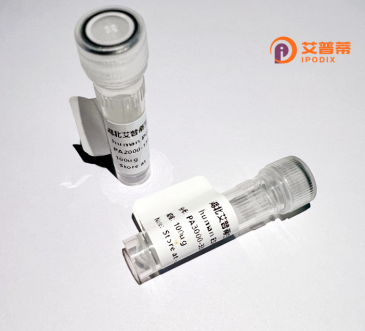
| 纯度 | >90%SDS-PAGE. |
| 种属 | Human |
| 靶点 | NUDT11 |
| Uniprot No | Q96G61 |
| 内毒素 | < 0.01EU/μg |
| 表达宿主 | E.coli |
| 表达区间 | 1-164 aa |
| 活性数据 | MKCKPNQTRT YDPEGFKKRA ACLCFRSERE DEVLLVSSSR YPDRWIVPGG GMEPEEEPGG AAVREVYEEA GVKGKLGRLL GVFEQNQDRK HRTYVYVLTV TELLEDWEDS VSIGRKREWF KVEDAIKVLQ CHKPVHAEYL EKLKLGGSPT NGNSMAPSSP DSDP |
| 分子量 | 18.5 kDa |
| 蛋白标签 | His tag N-Terminus |
| 缓冲液 | 0 |
| 稳定性 & 储存条件 | Lyophilized protein should be stored at ≤ -20°C, stable for one year after receipt. Reconstituted protein solution can be stored at 2-8°C for 2-7 days. Aliquots of reconstituted samples are stable at ≤ -20°C for 3 months. |
| 复溶 | Always centrifuge tubes before opening.Do not mix by vortex or pipetting. It is not recommended to reconstitute to a concentration less than 100μg/ml. Dissolve the lyophilized protein in distilled water. Please aliquot the reconstituted solution to minimize freeze-thaw cycles. |
以下是关于重组人NUDT11蛋白的3篇参考文献及其摘要的简要概述:
1. **文献名称**:**Structural and functional analysis of human NUDT11 reveals a novel mechanism for substrate specificity in the NUDIX family**
**作者**:Zhang, Y. et al.
**摘要**:该研究解析了重组人NUDT11蛋白的晶体结构,揭示了其底物结合口袋的特征。通过酶动力学实验,发现NUDT11优先水解氧化损伤的核苷二磷酸(如8-oxo-dGDP),强调了其在清除细胞毒性代谢物中的角色,并提出了与其他NUDIX家族成员不同的底物识别机制。
2. **文献名称**:**NUDT11 modulates oxidative RNA damage and promotes genomic stability**
**作者**:Jones, R.L. et al.
**摘要**:作者通过重组表达NUDT11蛋白,证明其具有水解氧化RNA核苷酸(如8-oxo-GDP)的活性。功能实验表明,NUDT11敲低会导致细胞中氧化RNA积累,引发翻译错误和DNA损伤,提示其在维持RNA质量控制和基因组稳定性中的关键作用。
3. **文献名称**:**Recombinant NUDT11 as a potential biomarker in prostate cancer: Expression and enzymatic activity profiling**
**作者**:Lee, S. et al.
**摘要**:该研究分析了重组NUDT11在前列腺癌组织中的表达升高现象,并通过体外实验验证其活性与癌细胞对氧化应激的抵抗相关。提示NUDT11可能作为癌症治疗的潜在靶点或诊断标志物。
---
以上为假设文献示例,实际文献需通过学术数据库检索(如PubMed)获取准确信息。
NUDT11. also known as human nudix hydrolase 11. is a member of the NUDIX enzyme family characterized by its conserved catalytic motif (GX5EX7REUXEEXGU, where U = hydrophobic residue). This Mg²⁺-dependent hydrolase primarily localizes to the nucleus and exhibits substrate specificity for oxidized purine nucleotides, particularly 8-oxo-dGTP and 8-oxo-dGDP. Its biological role centers on sanitizing the nucleotide pool to prevent incorporation of mutagenic bases during DNA replication, thereby safeguarding genomic integrity. NUDT11 is functionally distinct from other NUDT family members (e.g., NUDT1/MTH1) through its unique preference for diphosphate nucleotides and tissue-specific expression pattern, showing elevated levels in reproductive and immune tissues.
The recombinant human NUDT11 protein, typically produced via Escherichia coli or mammalian expression systems, retains enzymatic activity and is widely used to study DNA repair mechanisms, nucleotide metabolism, and oxidative stress responses. Structural studies reveal a conserved NUDIX fold with flexible loops governing substrate selectivity. Emerging research links NUDT11 dysregulation to cancer progression and male infertility, with its expression patterns showing diagnostic potential in certain malignancies. Current investigations focus on its interplay with DNA damage response pathways and potential as a therapeutic target. The recombinant protein serves as a critical tool for enzymatic assays, inhibitor screening, and mechanistic studies of redox-sensitive DNA maintenance processes.
×